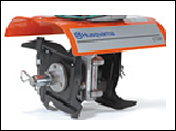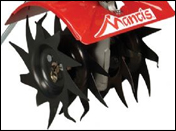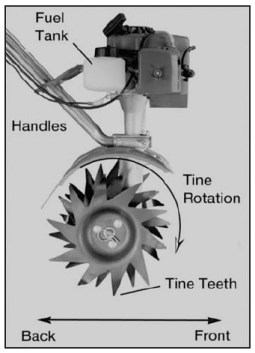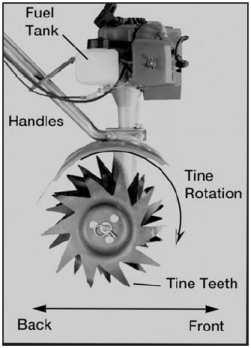![]()
FIRST VEGETABLE GARDEN
RAIN GARDENS
THE OZ VICTORY GARDEN
GARDENING TO SAVE MONEY
INCREASE YOUR BOTANY SAVVY
TILLING VS CULTIVATING
THE PERILS OF PEAT
THE DIRT ON SOIL
TINES, TINES, TINES
WHY AND HOW TO TILL
RENT OR BUY
HOW TO RENT & USE A BACKHOE
FALL LANDSCAPING TIPS
ECO FRIENDLY TIPS
USING GOOD PESTS TO FIGHT BAD PESTS
BUYING A LAWN MOWER?
TILLER CARE
COMPOSTING 101
MY NEW TILLER
AWARENESS WEEK
![]()
INTRODUCTION
SMALL TILLERS
MEDIUM TILLERS
LARGE TILLERS
HAND CULTIVATORS
WEBSITE REVIEWS
![]()
ABOUT THIS SITE
CONTACT OZ
CONTRIBUTION
JOIN THE DISCUSSION
RECOMMENDED READING
THE OZ BOOK STORE
Tine Design Time
Why is Tine Design Important?
Let’s start with small, or mini-tillers. Small tiller tine design is an interesting and important subject. After all, the tines are the only parts of the tiller that come into direct contact with the soil. Regardless of the power source – gas or electric, 2-cycle or 4-cycle, the tines do the work. And, like all tools, the tine’s design determines how well the work gets done.
The First Small Tiller
As you may already know by now I own and really like my Mantis Tiller. When I was considering buying a small tiller, I received a lot of mail from Mantis. I remember reading that the Mantis Tiller was first introduced by Little Wonder®, the parent company, as a tool for landscapers. It used cleverly designed and patented “serpentine” tines. I was told by the marketing folks at Mantis, when I visited their booth at the Philadelphia Flower Show, that these tines were carefully researched and developed over a period of time through trial and error (that must have been a fun project!). They were specifically designed to rip through soil in spite of the tiller’s light weight.
Because of their design, the serpentine tines attack the soil like a saw blade attacking wood. Actually, they’re more like a set of curvy saw blades that do more than just cut a slit; they cut an 8” wide swath. (I remember seeing a video that showed their tines actually chewing through particle board!)
Serpentine Tines are Reversible
The Mantis serpentine tines are also reversible; they can be used in the more aggressive tilling mode where the teeth really bite into the soil or sod, or they can be used in the cultivating position, where they tend to cultivate only the top 2 or 3” of the garden’s surface.
Mini “Bolo” Tines
When I was considering the purchase of a small tiller, most of the other manufacturers used mini “bolo tines” like the tines shown below. These tines tend to attack the soil more like a golf club than like a saw blade. While the bolo design works quite well for large, heavy tillers whose tines rotate a slower rpm’s, in my opinion the design doesn’t work as well on lighter tillers whose tines rotate at much faster speeds.
 |
 |
Mini-bolo tines |
Serpentine Tines |
Hoffco manufactures a small tiller that comes with mini-bolo tines, but they also offer “digging tines” as an additional attachment. Their digging tines are similar to the serpentine tines, except that they’re not as “wavy.”
Think of it this way … Would you rather break up soil with a bunch of spinning saw blades or a bunch of little golf clubs?
Medium and Large Tillers
Virtually all medium and large tillers use some sort of bolo tine design. The major differences among tillers – as far as the tines are concerned – are the width and depth of tilling.
Most of the medium size tillers are “front-tine tillers” that are designed so that the tines spin in a forward direction, pulling the tiller forward. Tilling occurs as the operator applies physical pressure to hold back the tiller’s motion, which causes the tines to dig into the soil. Using a medium size front tine tiller runs the gamut of being a pleasant workout to hard work.
Virtually all large tillers are rear-tine tillers. A key difference is that rear tine tiller tines are powered independently from the wheels. So, you can speed up the tines without speeding up the distance covered, or how fast you need to walk to keep up with the tiller. The independent operation of the tines and the wheels enables you to control how deep you till the soil.
Another key tine difference on some large tillers is the concept of counter-rotating tines. While I’ve never used a tiller with counter-rotating tines, I’ve read and heard from others that they’re not as easy to use as traditional forward rotating tines.
Well, that’s about all I know about tines.
If you have any comments, I’d really like to hear from you.
OZ Gardener
The Garden Of Oz
Feel free to share this article however it has to be copied and published the same way as on this website, without any changes and please include a link to the original material.
Reviews
Read Reviews (2)Write a Review
Avg Rating:

4.5 out of 5
 February 21, 2013
February 21, 2013By: Shawn in Silverdale Wa
I am starting my 5th season in my backyard veggie garden. I have been composting (started with a pile, but now have 4 ea 25sf bins) for 6 years. I picked up a Mantis at a yard sale it would not run. I just got it back from the shop ~ WOW Wonderful little machine! why didn't I get one of these sooner. I use to double dig my garden beds by hand every spring. I have just over 500 sf of raised garden beds ~ that equals a LOT of hand work. Thanks for all the wonderful articles. LOVE MY MANTIS!
 November 1, 2010
November 1, 2010By: San
good info



